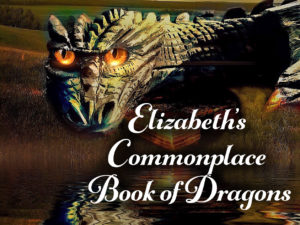Understanding Dragon Ranks

Peek into Elizabeth Bennet’s world of dragons through her commonplace book of dragon experiences.
If you missed the start of grown up Elizabeth’s adventure with dragons, check out this post . If you missed the first installment in Elizabeth’s Commonplace Book, you can find it here.
July 1801
I am so excited! I can hardly believe it! Papa has said it is time for me to prepare to meet Longbourn! I feel like I am filled with fairy dragons all vying to get out!
I must be patient though, for he says there is much for me to learn and to do before I am ready to meet a major dragon. But for now, it is enough that he says it is time to begin. I shall apply myself very hard to my lessons and I know it shall not be too long.
 My first lesson is to learn all the dragon ranks, their precedence and the responsibilities of each rank. I spent all morning studying—they are much easier to recall and understand than the ranks of men, though Mama would be horrified to know I think so. To test myself, I shall write them here.
My first lesson is to learn all the dragon ranks, their precedence and the responsibilities of each rank. I spent all morning studying—they are much easier to recall and understand than the ranks of men, though Mama would be horrified to know I think so. To test myself, I shall write them here.
Dragons are ranked first by their size and power. All the major dragons, those bigger than a large horse—that is an odd designation, I should say if anyone asked me, but no one will, so I shall keep that opinion to my commonplace book—outrank all the minor dragons, smaller than themselves. The major dragons are like our upper class and the minor dragons, the lower ones.
Among the major dragons, the most powerful species are above the weaker ones, so a wyvern like Longbourn is one of the lowest ranked major dragons. If he is so fearsome, I can hardly imagine what a highly ranked dragon might be like!
The Pendragon accords established the relative ranks for the major dragons so they no longer fight for precedence. But without the accords, they would likely battle for position, especially when a major egg is laid and a young dragon hatches to take a place of high rank. I understand those were dangerous times, when dragon war was likely. Now those transitions are peaceful.
The dragons of England are led by their Brenin, Buckingham. He is like our king. A fire drake, he administers dragon law and the Pendragon Accords across England and deals with necessary matters with dragons of other lands.
How exciting it is to think of all the exotic dragons that must be in the east. Their silks and art depict so many wonderful dragons! I wish I could meet them some day.
Underneath the Brenin (or Brenhines if it were a female dragon) are the Dugs (and Duges) who sit on the Dragon Conclave. They administer the different counties and, with the Conclave, decide matters of dragon law. I think they are all fire drakes, but I am not entirely sure. What kind of major dragon would match a lesser firedrake in power?
I will have to look that up.
Cownts and Cowntesses serve under the Dugs. It seems like they should rule counties, but they do not. They are responsible for regions in their counties, managing the major dragons and their keepers. And so it goes down through the Vikonts and Vicontes, the Barwins and Barwnes, Marchog and Marchoes down to the lowly Lairds and Lairdas who are the lowest of the major dragons. Papa says they are the gentlemen and ladies among the dragons.
 Longbourn is a Laird. His task is to manage all the minor dragons in his territory. It sounds a little like managing children, but I am sure it is much more important than that.
Longbourn is a Laird. His task is to manage all the minor dragons in his territory. It sounds a little like managing children, but I am sure it is much more important than that.
I wonder how many minor dragons live on Longbourn estate. Perhaps I might ask when I meet him, unless of course Papa thinks it would be impertinent—though I have read that dragons are not nearly so bothered by impertinence as people are.
In the meantime, I shall practice my deepest curtsey. That is the way that all major dragons must be greeted, with one’s head down and knee nearly touching the ground. It is difficult to do gracefully, so I am glad it is the only obeisance I must learn.
Mama has just left to pay a call on Lady Lucas, so it is a very good time to practice. I shall do that now.
Please support this author and this site by using this affiliate link.

Loved this post! It’s fascinating to see the various classes of dragons.
Is this ranking gleaned from a source, or is it all yours?
Thank you for this intriguing post!!
Warmly,
Susanne 🙂
Thanks, Susanne. It is based loosely off some research I did, but the application to dragons is my own. 🙂
Is this ranking of dragons what you mentioned in an earlier post, when you talked about working things out with your family? I love it! I’ll have to bookmark this page for future reference.
Actually not, surprisingly enough. This came out of some other research into social rankings. Thanks, Anji!